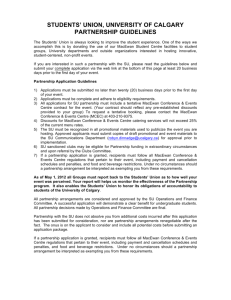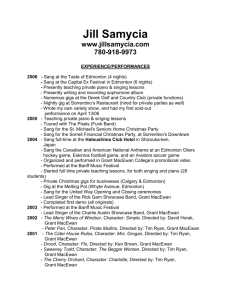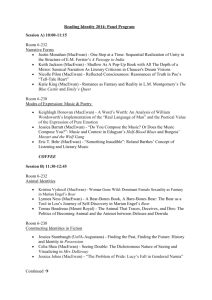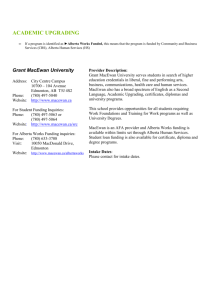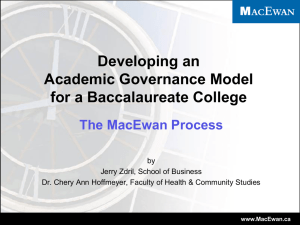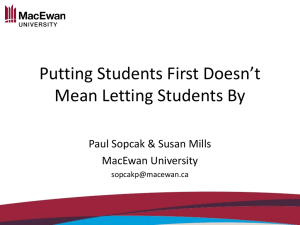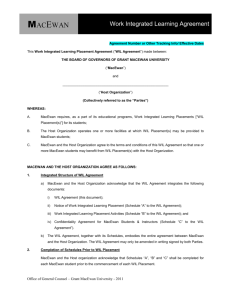Redesigning Continuing Education for Nursesx
advertisement
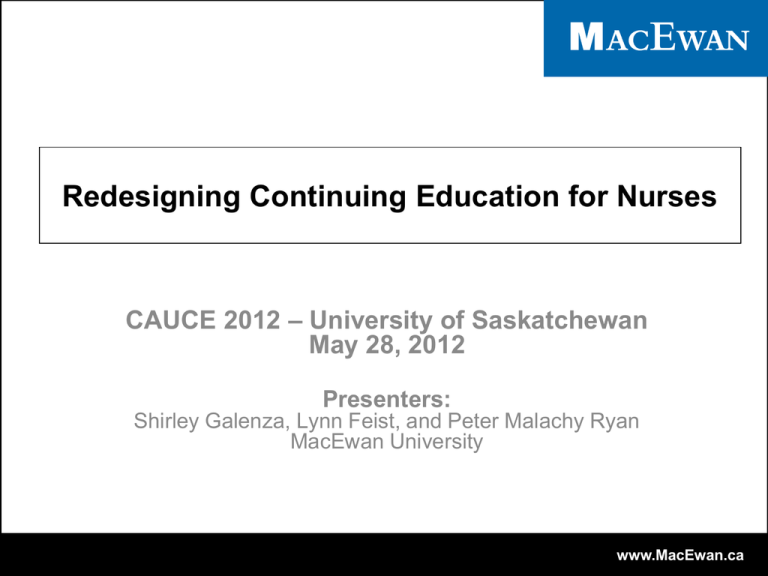
Redesigning Continuing Education for Nurses CAUCE 2012 – University of Saskatchewan May 28, 2012 Presenters: Shirley Galenza, Lynn Feist, and Peter Malachy Ryan MacEwan University www.MacEwan.ca Agenda 1. Introductions 2. Session Objectives 3. The Nursing Refresher Program (NRP) 4. Successes and Challenges 5. Participatory Design (PD) Principles 6. Review Handout: Best Practices for Distance Education 7. Workshop: New NRP Course Standards www.MacEwan.ca Session Objectives After attending this session, participants will be able to do the following: 1. Advocate for distance students and faculty within a university. 2. Discuss the use of participatory design in revitalizing the Nursing Refresher program at MacEwan University. 3. Discuss best practices found in the literature related to online education. 4. Describe the lessons learned by faculty and staff within the Nursing Refresher program. www.MacEwan.ca The Nursing Refresher Program (NRP) • Helps previously practicing degree and diploma educated nurses to meet currency of practice requirements and regain their provincial licensure as a Registered Nurse. • In 1973, Dr. Gerri Nackonechny began the NRP at then Grant MacEwan College as a face-to-face program. • In the 1980s, a projected critical shortage of nurses led to the NRP being developed to have an expedited flexible, accessible delivery. • The program was later implemented in Australia in 1987, and translated and adapted in Russia and the Ukraine from 20002005, because of its forward thinking design. www.MacEwan.ca The Nursing Refresher Program (NRP) • The distance education program was built using a continuous monthly intake model; it is not term based. • From 2008-2011, the average success rate of students for completing the NRP in Alberta was 73.96% (284 students out of 384). • We wanted to look for ways to change or improve the courses and delivery. www.MacEwan.ca Challenges and Successes CHALLENGES SUCCESSES 1. Needed to maintain flexibility but also address issues of isolated student. 1. Increased student success, engagement, and satisfaction through on-line delivery. 2. Faculty ownership. 2. Increased instructor presence. 3. Developing an on-line Case Study tool to include PBL. 3. Created a community of learning. 4. LMS and Exam software updates. 4. Tracking student progress. www.MacEwan.ca Participatory Design (PD) Principles 1. PD developed in Scandinavian countries in the 1970s. 2. Allows designers to harness different learning theories during various stages of the design process (e.g. Behaviorist, Cognitivist, Systems theory, etc.). 3. Involves interviews with key stakeholders to include their tacit knowledge in the design process. 4. PD is consensus based and democratic. www.MacEwan.ca Four Key Lessons of the NRP Redesign Process (1) Instructor Presence/Community of Learning: Building instructor presence into the course helped faculty to take ownership, and build a community of learning, thereby avoiding student isolation in a continuous intake course. (2) On-line Classes: Availability of technological tools provide ability to re-design content delivery and sense of community. (3) F2F/Distance Education: Any distance education components that are developed can increase social interactions in face-to-face classrooms as well as other online courses (e.g. modularity). (4) Augmented Learning: Technology-enhanced education makes learning experiences easier and far more engaging if they are structured appropriately to avoid information overload. www.MacEwan.ca The Pilot Program Results: A Student Problem Log Student Feedback and Actions Taken ID # Date Feedback Actions Taken #0001 Sept. 13, 2011 - LEARNING ACTIVITY ISSUE: A student reported that they could not find Theory A - Module 3’s Learning Activities #1 and #2 online on Blackboard. - LEARNING ACTIVITY ISSUE: The particular course section was not copied over properly on Blackboard, and the content was made available immediately once the issue was identified. #0002 Sept. 22, 2011 - COURSE CONTENT ISSUE: The student was unable to access two of the “Required Readings” for Theory A - Module 1 online from the university library. - COURSE CONTENT ISSUE: The readings were previously provided as printed copies and had become dated. The readings were moved to the “Suggested Readings” section, because not all students could access them easily from different provincial regions, but they will be deleted after the pilot because students still found them difficult to access. www.MacEwan.ca New Blackboard Course Standards www.MacEwan.ca The Checklist www.MacEwan.ca The Tool Shed www.MacEwan.ca Distance Education Advocacy • Making and ensuring the place for distance/continuing education within the institution. • Developing processes and bridging gaps. • Advocating for students. www.MacEwan.ca Workshop Questions 1. What strategies have you used to build consensus for similar projects? 2. What changes might you recommend to our course standards and checklist? 3. What types of activities could be added to the Tool Shed to better showcase the benefits of Blackboard for student engagement? 4. Has reviewing our process been helpful for your own projects? www.MacEwan.ca Conclusion • The future of instructional design is in using evidence-based augmented learning strategies to engage students in their learning. • Students can be engaged on-line by leveraging a Learning Management System’s features that support increasing instructor presence, reinforcing key concepts through targeted learning activities, and creating interactions that support the development of a learning community. www.MacEwan.ca

